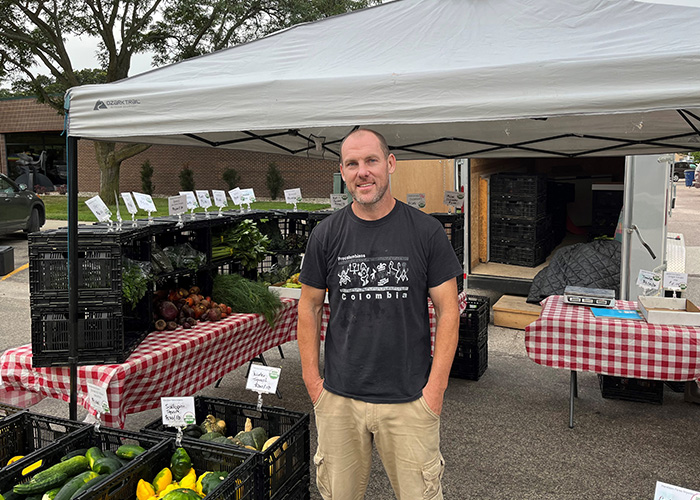Feb 22, 2024
Fridays on the Farm: Kyle Haroldson
Editor’s note: In its Fridays on the Farm series, the USDA recently featured Kyle Haroldson, an organic farmer in Brookings, South Dakota. He started his operation to sell organic produce directly to customers. As an organic producer, he filled an uncommon niche in South Dakota, and the exclusive nature of his operation gives him a special position in the market.
Kyle Haroldson’s transition into agriculture wasn’t straightforward. The Haroldson family has been on the land near Brookings for five generations, but Kyle Haroldson left after studying economics at South Dakota State University.

After graduating, he learned Portuguese and worked with energy firms in Brazil as well as U.S. companies. After the hustle and bustle of his career, Haroldson decided to return home to start a family and change his profession.
He saw an opportunity through his brother, who at the time was working for an organic supplier and needed organic goods for his customers. It was there that Haroldson’s business began to take shape.
“There are only a handful of organic operations out here, and people are looking for local organic produce,” Haroldson said.
Because of the intensive nature of organic production and the high cost of labor, Haroldson opted to keep his operation at around two acres. On occasion, his parents will help at farmer’s markets, and he’ll hire high schoolers to fill some gaps, but beyond that, Haroldson runs the operation himself.
Overcoming Challenges
Running an organic operation has its challenges and are like those faced by other producers. However, the methods to tackle them are often limited.

“Wind is always a concern in South Dakota, but the biggest problem I face is pests,” Haroldson said. “I can only spray organically approved pesticides as an organic operation.”
Organic certification has many conservation-minded standards built in, and as an organic producer, Haroldson has embraced those methods of addressing concerns. Since his father is a producer as well, Haroldson was familiar with USDA and the Natural Resources Conservation Service (NRCS). As he began his operation, Haroldson worked with NRCS to establish a high tunnel to protect his crops, plant cover crops to address soil compaction, in addition to pest and nutrient management and pollinator plantings through the Environmental Quality Incentives Program (EQIP).
Being an organic producer, there are several requirements that Haroldson must adhere to in order to keep his certification. His conservation plan through NRCS ensured that those standards were met and in line with his goals.
“We worked with Kyle to come up with plans that best served him,” said NRCS District Conservationist Jeremy Sova.

In addition to EQIP, USDA has resources and services available for new and established organic operations. To support farmers transitioning into organic production, the Organic Transition Initiative provides mentoring and advice, direct farmer assistance, and organic market security through a suite of multi-agency programs, including conservation assistance from NRCS. Additionally, the Farm Service Agency’s Organic Certification Cost Share Assistance Program can give producers up to 75% reimbursement of organic certification costs.
In addition to EQIP, USDA has resources and services available for new and established organic operations. Photo by Andrew Thomason, NRCS.
Looking to the Future
Haroldson looks to continue expanding on the agricultural niche his operation fits. “My goal is to keep taking little steps to be more efficient,” he said. “That’s the only way I’m going to be able to sustain my operation.”
Haroldson is looking to add more conservation practices, including more high and low tunnels to help protect crops from wind and hail and extend the season, mulching to help control weeds, and irrigation management to have a more efficient and effective water system. He also looks to expand into more markets to bring more fresh organic produce to South Dakota.

Haroldson plans to expand into more farmers markets to bring more fresh organic produce to South Dakota. Photo by Andrew Thomason, NRCS.
“I want to get into more stores and co-ops, and also see if I can work with local schools as well,” Haroldson said.
From unique beginnings to a growing organic business, Haroldson has levied conservation practices to create a sustainable vegetable farm to feed his family and community.
NRCS conservation practices have helped Haroldson create a sustainable vegetable farm to feed his family and community. Photo by Andrew Thomason, NRCS.
More Information
Visit local farms, ranches, forests, and resource areas through USDA’s Fridays on the Farm stories. Meet farmers, producers and landowners who are working to improve their operations with USDA programs.
USDA offers a variety of risk management, disaster assistance, loan, and conservation programs to help producers weather ups and downs in the market and recover from natural disasters as well as invest in improvements to their operations. Learn about additional programs.






